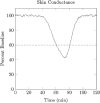Hypo- and Hyperglycemic Alarms: Devices and Algorithms
- PMID: 25931581
- PMCID: PMC4667339
- DOI: 10.1177/1932296815583507
Hypo- and Hyperglycemic Alarms: Devices and Algorithms
Abstract
Soon after the discovery that insulin regulates blood glucose by Banting and Best in 1922, the symptoms and risks associated with hypoglycemia became widely recognized. This article reviews devices to warn individuals of impending hypo- and hyperglycemia; biosignals used by these devices include electroencephalography, electrocardiography, skin galvanic resistance, diabetes alert dogs, and continuous glucose monitors (CGMs). While systems based on other technology are increasing in performance and decreasing in size, CGM technology remains the best method for both reactive and predictive alarming of hypo- or hyperglycemia.
Keywords: alarm systems; continuous glucose monitoring; hypoglycemia; low glucose suspend.
© 2015 Diabetes Technology Society.
Conflict of interest statement
Figures




References
-
- Clarke SF, Foster JR. A history of blood glucose meters and their role in self-monitoring of diabetes mellitus. Br J Biomed Sci. 2012;69(2):83-93. - PubMed
-
- Olmsted JMD, Logan HD. The effect of insulin on the central nervous system and its relation to the pituitary body. Am J Physiol. 1923;66:437-444.
-
- Cannon WB, McIver MA, Bliss SW. Studies on the conditions of activity in endocrine glands. Am J Physiol. 1924;69(1):44-66.
-
- Foshay L. Observations upon the action of insulin on the blood, with special reference to the cause of the condition known as hypoglycemia. Am J Physiol. 1925;73(2):470-479.
Publication types
MeSH terms
Substances
Grants and funding
LinkOut - more resources
Full Text Sources
Other Literature Sources
Medical

